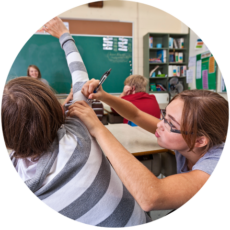
Challenging School Behavior
Research has shown that Positive Behavioral Interventions Strategies (PBIS) are effective in changing behavior in schools. When a school environment is positive and predictable, students feel safer, have better academic performance, higher test results and make better behavior choices. Schools also show a gain in instructional time, a reduction in out-of-school suspensions and discipline referrals, and a decrease in referrals to Special Education. Schools show an increase in instructional time, reduction in out-of-school suspensions and discipline referrals, as well as, a decrease in referrals for Special Education.
When a student engages in challenging behaviors within the school setting, the school may conduct a Functional Behavioral Assessment (FBA) to determine possible reasons for the behavior. If your child is on an IEP or Section 504 plan, you may need to request a team meeting to address your concerns. The IEP team should consider conducting a Functional Behavior Assessment (FBA) and developing a Behavior Intervention Plan (BIP) to help the student modify challenging behaviors.
Consider these steps as you work with school professionals to determine the behavioral needs of your student:
- Identify and agree on the behavior(s) that need to change. The identification process begins with describing the challenging behaviors so that everyone understands the concern. If a child has many problem behaviors, it is important to focus on those that are the most serious. Usually, the IEP team meets to discuss what has been occurring in school with input from the parents.
- Determine where the behaviors do and do not occur. The team may conduct interviews, perform observations, and discuss the following questions:
-
- What is different about the places where the behaviors do not occur?
- What is different about the places where the problem behaviors do occur?
- Is the problem behavior related to how the child responds to the teacher or peers?
- Does the number of other students present, or the difficulty of the schoolwork, cause a problem?
- Does the time of day or a child’s mood affect the behavior? Are there daily problems for the child (such as on the bus in the morning, or challenges with peers in the hallway)?
- Do the behaviors occur in a specific set of circumstances or a specific setting?
- What specific events seem to support or influence the problem behaviors?
3. Collect information on the child’s performance from as many sources as possible. There may be other places to get information about the child’s challenging behaviors. That may include a review of previous assessment data, behavior incident reports, and other documented information the school has about the child’s behavior. Parents may want to share information from other assessments or sources, including mental health providers. While this is good information to know, parents should be knowledgeable about how much private health information they should share.
4. Develop an informed guess about why problem behaviors occur (the function of the behaviors). Using all the information gathered through observation and review of data, an idea of why the behavior occurs is proposed. This helps predict where and why your child’s problem behaviors are the most and least likely to occur.
5. Identify behaviors that can be taught and supported within the school; provide your child with positive alternatives to the problem behavior(s). Some students need to be taught appropriate behavior repeatedly and receive positive input to reinforce the changes.
Resources
- What’s Next After Gathering Data? Writing the Behavioral Intervention Plan: https://utahparentcenter.org/behavior-lrbi/behavior-intervention-plan/
- Examples of Positive Behavioral Intervention Strategies: https://www.pacer.org/parent/php/php-c215b.pdf
- Sample Behavior Intervention Plans for anxiety, frustration, inattentiveness, defiance, poor attendance and so much more: https://www.pbisworld.com/tier-2/behavior-intervention-plan-bip/
- Example PBIS Classroom Plan for High School: https://www.pbis.org/resource/creating-effective-classroom-environments-plan-template
- RETURNING TO SCHOOL: CONSIDERATIONS FOR STUDENTS WITH THE MOST INTENSIVE BEHAVIORAL NEEDS A Guide to Supporting Students With Disabilities, Their Families, and Educators: https://assets-global.website-files.com/5d3725188825e071f1670246/607ef1f0d6eeeef65ee0a141_CurrentDraft_TBS_Intensive%20Intervention_April2021Updates.pdf
- Utah Parent Center: Behavior Resources






